Kerr is a range of Mason jars for home canning. They can also be used for freezing, dry storage, and decorative functions.
Kerr has traditionally been primarily marketed in the western United States, where it has historically had a customer base loyal to the brand name.
Kerr Jars Today
Many people like Kerr jars because of the clean sides on the main, everyday jars in the Kerr product line. The clean sides, some people feel, allow labels affixed onto the jars to hold better. (Note: Not all Kerr jars are smooth-sided. The jelly jars have quilted-texture sides.)
Regular mouth Kerr jars are available in 4 oz (125 ml), ½ US pint ( 250 ml), ¾ pint (375 ml), 1 US pint ( 500 ml), and 1 US quart (1 litre).
Wide mouth Kerr jars are available in ½ US pint ( 250 ml), 1 US pint ( 500 ml), and 1 US quart (1 litre).
The jars themselves are dishwasher safe. They take standard size mason jar lids and ring bands.
Note that, as for all mason jars, if you want freezer-safe ones you need to look for straight-sided jars.
The Kerr name for home canning supplies is owned by the Newell (formerly Jarden) company, which also owns the Ball and Bernardin preserving supplies companies (info current as of 2016.) [1]It’s interesting to note that while Bernardin is owned outright by Newell, Kerr and Ball have also continued as separate companies outside the home canning field making other things such as beverage and medicine containers. Bernardin, along with Golden Harvest, are the two home canning names that Newell owns lock, stock and barrel. Ball is primarily marketed in the eastern United States, while Newell tries to preserve Canadian sales territory for Bernardin.
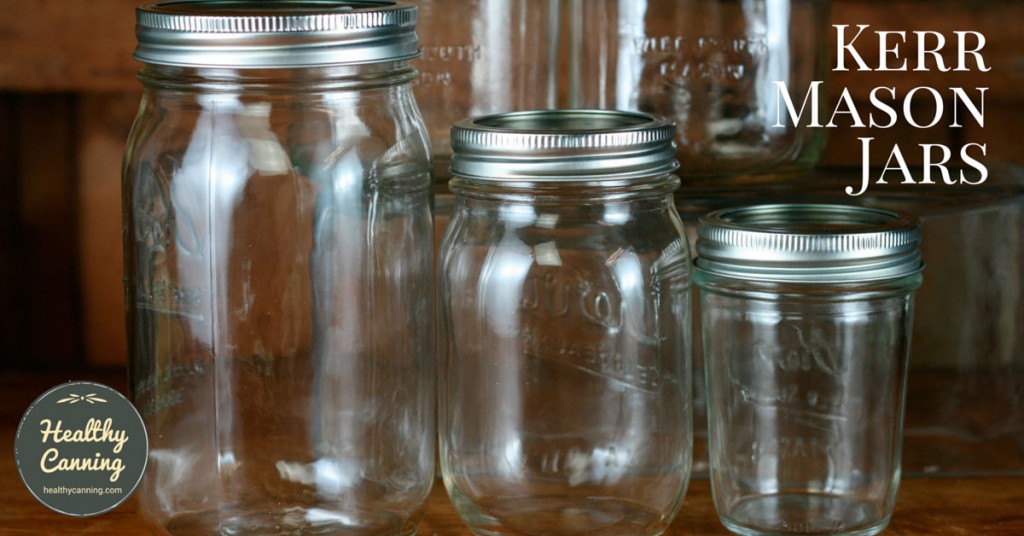
Smooth sided Kerr mason jars
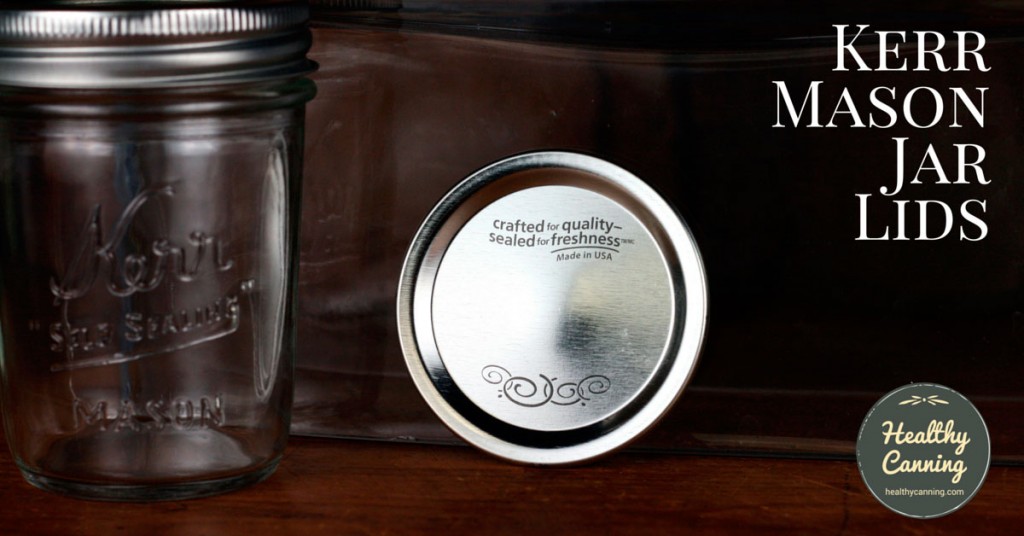
Kerr mason jar lid
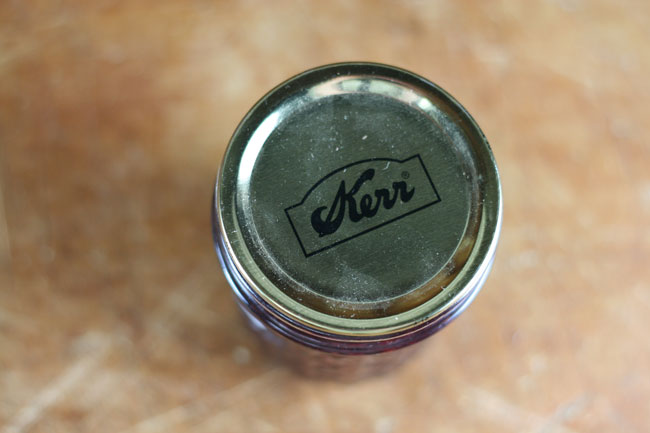
Older Kerr lid
Kerr Publications
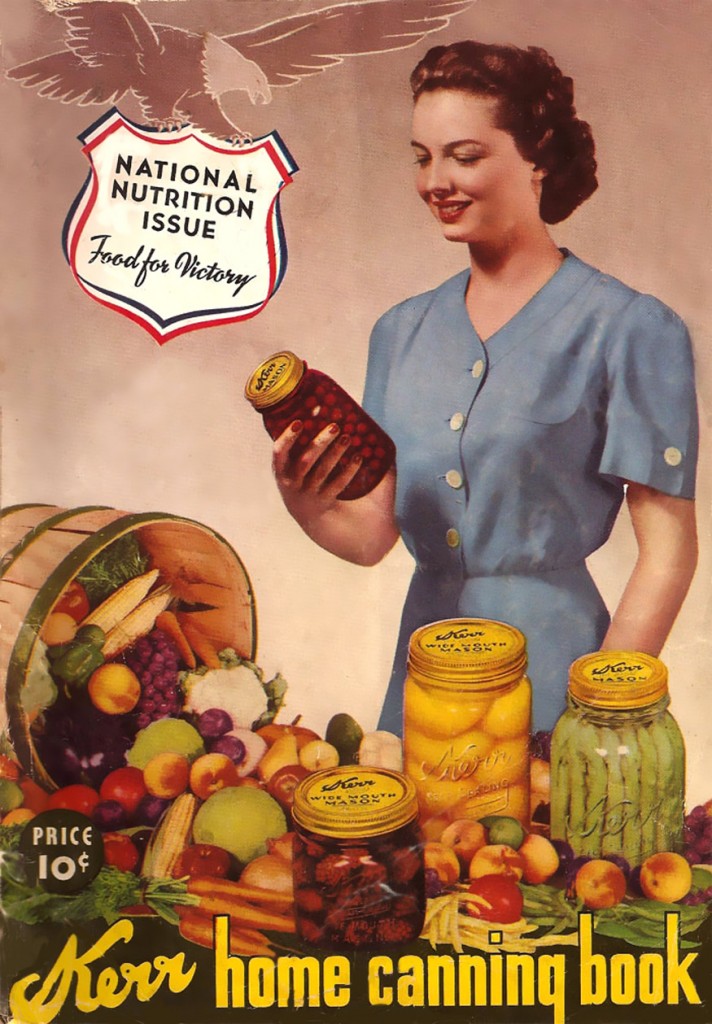
Kerr Home Canning Book, World War II
Kerr used to issue canning guidance and manuals, which was considered sound for its day. Advice such as:
Canning publications appear to no longer be issued under the Kerr name. Newell issues them instead under the Ball and Bernardin names.
Any Kerr publications, as good as they were in the day, would now be considered out of date and should be referred to for historical interest purposes only. Use instead current publications from reputable sources, as much has been discovered in the field of home canning since Kerr’s knowledge transfer people were active.
Researching Kerr Jars
Are you a jar collector and want to find out about a particular Kerr jar you have? Try this web forum over on the Glass Bottle Marks web site.
History of Kerr Jars
While Ball now has all the recognition in home canning, it was actually Kerr who introduced two fundamentals we now use today: a mason-jar lid with the gasket affixed to its underside, and, wide-mouth jars. Ball copied these innovations.
The Kerr jar company was founded by Alexander H. Kerr, born 4 September 1862 in Philadelphia, Pennsylvania.
After some basic schooling, he migrated west. He went first to southern Idaho, where he ended up in the retail grocery trade. From there, he moved to Portland, Oregon and worked in sales for a business named Mason-Ehrman; after that, he joined two other men to form a produce business named Richet, Roberts & Kerr.
In 1897, he helped form a wholesale grocery company on Front Street in Portland, Oregon, named “Wadhams and Kerr Bros.” The people behind the business were William Wadhams, who supplied the capital for the business, plus three Kerr brothers: Alexander H. Kerr, Samuel C. Kerr and Francis R. Kerr. [2] Bill Lockhart, Beau Schriever, Bill Lindsey, and Carol Serr. Giles-Clough Glass Co. and Related Companies. Page 71. Accessed June 2016 at https://sha.org/bottle/pdffiles/Giles-CloughGlass.pdf
In 1903, Alexander left that grocery business and with only $100 US started a company called either the Hermetic Fruit Jar Company or the Hermetic Closure Company (sources found to date disagree.) His partner was John Giles. The company made metal lids and spring clips. [3] Milner, Melissa. Fruit Jars – A history worth remembering. In: Bottles and Extras. Federation of Historical Bottle Collectors. Winter 2004. Page 30.
In 1904, Kerr changed the name of the company to the Kerr Glass Manufacturing Company.
His first jars were called “Economy” jars. They were not screw-on lids; they were clamp-type lids which had a rubber gasket attached to the underside of the lid, incorporating elements from a design patented by Julius Landsberger in 1903. The jars and their lids were very similar in operation to the Fowlers Vacola jars still used in Australia today. The Economy jars were made at Kerr’s Altoona and Sand Springs factories (see list below.) The company would go on to make the Economy jars until 1957, and replacement lids for them until 1961.
From 1904 to 1912, Kerr kept his business offices in Portland, Oregon. Then, in 1912, he moved the office to Chicago.
During those first years, Kerr did not actually make his own jars. He had two other companies manufacture them for him: the Illinois Pacific Glass Company in San Francisco, and the Hazel Atlas Company. [4]Kerr Glass Manufacturing Corporation. In: Lehman Brothers Collection – Contemporary Business Archives. Harvard Business School. Accessed June 2016 at https://www.library.hbs.edu/hc/lehman/company.html?company=kerr_glass_manufacturing_corporation
In 1909, Kerr finally had enough business to open his own first manufacturing plant, in Altoona, Kansas.
In 1915, he came up with another simple one-piece flat disc-and-gasket combination for lids, similar to the Economy lids design, but held in place during processing by a screw-on ring band instead. He called his lids, which are the ones we use today, “self-sealing” because after processing you don’t touch the lids at all; they will seal themselves. Other models at the time required you to re-tighten a lid, or snap down a clamp, as well as often using separate independent red rubber rings for the actual sealing. [5]Keefe, Joni. Farms Finest: Mason jars preserve food and American history. Aspen, Colorado: Aspen Times. 19 October 2014
In 1915, he moved his office to Sand Springs, Oklahoma, and then in 1919 to Los Angeles, California. They would remain there until 1992, though the company was incorporated in Delaware.
Factories established or bought by Kerr include: [6] Whitten, David. Kerr Glass Manufacturing Corporation. Web page. Accessed June 2016 at https://www.glassbottlemarks.com/kerr-glass-manufacturing-corporation/
- Altoona, Kansas (from 1909-1912);
- Sand Springs, Oklahoma (1912 – 1992) [7]Ball Glass Closing Plant in Sand Springs. The Oklahoman. 25 June 1992. ;
- Huntington, West Virginia (1933 to 1982);
- Santa Ana, California (1943 – 1992)[8]Ball Glass Closing Plant in Sand Springs. The Oklahoman. 25 June 1992. ;
- Plainfield, Illinois (1964 – ?);
- Dunkirk, Indiana (1968 – ?);
- Millville, New Jersey (1968- 1983);
- Waxahachie, Texas (1968- 1983);
- Maywood, California (? – 1983);
- Wilson, North Carolina (? – 1983). [9] “In September 1983, the company sold off four of its glass manufacturing facilities, located at Millville, New Jersey; Maywood, California; Waxahatchie, Texas; and Wilson, North Carolina, to National Can Corp.” Funding Universe. Kerr Group Inc. History. Accessed June 2016 at https://www.fundinguniverse.com/company-histories/kerr-group-inc-history/
In 1920, Kerr introduced what is now the standard 3 inch (76 mm, inner diameter) wide-mouth mason jar:
Up until the early part of the twentieth century, jars were produced with what is now considered a standard, regular mouth opening of approximately 2 ½ inches. It was Kerr who, in 1920, started producing jars with a 3 inch opening, which he dubbed “wide-mouth.” Soon thereafter, Ball copied the design and started producing wide-mouth jars as well.” [10]Moser, Joann. Mason Jar Nation: The Jars that Changed America. Cool Springs Press. 2016. Page 18.
By 1921, Kerr had begun selling jars in western Canada.
By the 1930s, jars with the screw-on ring bands were more popular than the Economy clamp-type models.
During World War Two, some Kerr jars shipped without their metal lids. A participant in an antique jar forum wrote,
I have a sealed box of 1 dozen ½ pt Kerr Squat Jelly Glasses. They do not have lids due to the WAR…. The box has a note: “METAL IS NEEDED FOR WAR. The War Production Board Will Not Permit Metal For Jelly Lids. These Jelly Glasses packed without lids. HELP WIN THE WAR!” They were boxed at the Sand Springs Oklahoma Plant.” [11]User Katie. 26 August 2016. Kerr Squat Jelly Glasses. User posting.
In 1944, the company began putting AHK (standing for Alexander H. Kerr) on the bottom of some jars.
In 1970, the company finally went public.
In 1975, the company did a second public offering, to retire some debt and recapitalize. At the time, the company had seven factories, and 27 sales offices.
In the 1990s, Kerr began a period of erratic moves that some attribute to a poor leadership at the top:
The company ended up floundering under the direction of Roger Norian, according to one industry analyst, who said in Forbes, “Roger Norian hasn’t done much for Kerr Group, but he’s done very nicely for himself,” and noted that “Kerr had been profitable less than 50 percent of the time from 1982 to 1993, although Norian himself had received over $1.8 million in three years.” [12]Funding Universe. Kerr Group Inc. History. Accessed June 2016 at https://www.fundinguniverse.com/company-histories/kerr-group-inc-history/
In 1992, it was decided that the company would rename itself to The Kerr Group. The company was no longer just a mason jar company, or even just a glass making company, at that. It was making different types of packaging, containers and closures for far more than home canning, including glass bottles for commercial condiment makers, etc. Kerr sold the division that made commercial glass bottles for packers off to the overall Ball Corporation in 1992. [13] Nearly a decade later, in February 1992, the company sold its commercial glass container manufacturing business to Ball Corporation for approximately $68 million.” Funding Universe. Kerr Group Inc. History. Accessed June 2016 at https://www.fundinguniverse.com/company-histories/kerr-group-inc-history/
The company began focussing on other things such as plastic closures for the pharmaceutical industry. [14] Whitten, David. Kerr Glass Manufacturing Corporation. Web page. Accessed June 2016 at https://www.glassbottlemarks.com/kerr-glass-manufacturing-corporation/
Kerr had, though retained ownership of its original domestic home canning jars, supplies, and lids division. They decided to try to expand in Canada, where previously they had only sold in the western half of the country:
In 1992, Kerr began to market caps, lids and jars in the Atlantic provinces and, shortly thereafter, it moved into the larger Quebec and Ontario markets.” [15] Canadian International Trade Tribunal. Inquiry: CAPS, LIDS AND JARS SUITABLE FOR HOME CANNING, WHETHER IMPORTED SEPARATELY OR PACKAGED TOGETHER, ORIGINATING IN OR EXPORTED FROM THE UNITED STATES OF AMERICA. Inquiry No.: NQ-95-001. October 1995. Page 12.
In 1996, though, despite still having 45% of the U.S. market, and despite just having started to execute sales expansion plans, the company just gave up on the home canning supplies market, and sold that division to the Newell (named Alltrista at the time) company. Newell closed Kerr’s factory in Jackson, Tennessee and consolidated Kerr and Ball production in Muncie, Indiana.
Until 1996, the company was a leading manufacturing of home canning supplies, through its consumer products business division, with an estimated 45 percent market share, continuing the work originally started by A. H. Kerr in 1903. Those operations included the manufacture and sale of caps and lids and the sale of canning jars and lids used by consumers for home canning of fruits, vegetables, jams, jellies, and the like, together with the sale of other related products, including iced tea tumblers and beverage mugs, and plastic dinnerware and drinkware.
Due to a combination of cyclical demand based on annual growing, harvest, and weather conditions; a shift in retail distribution channels for such supplies away from smaller specialty stores and into the larger mass-merchandise retailers such as Wal-Mart and Kmart (with concurrent lower profit margins); and little growth in the unit, operations for the consumer products division were discontinued. Certain assets of the division were sold in March 1996 to Alltrista Corporation for a purchase price of $14.5 million in cash and stocks. Alltrista, parts of which formerly belonged to Ball Corp., was another Muncie, Indiana-based company. The manufacturer of metal stamped jar tops, rubber jar rings, and glass jars for packing, founded in 1991, also produced zinc blanks used to make pennies. Revenues for Kerr hit in the normal range for the struggling company, at $107.4 million, but net losses mounted to $22.3 million. [16]Funding Universe. Kerr Group Inc. History. Accessed June 2016 at https://www.fundinguniverse.com/company-histories/kerr-group-inc-history/
Even though it’s no actually no longer in the home canning business, and has sold off the Kerr name in that product line to Newell, the main Kerr Group company is still in business today (2016) as a commercial packaging company:
Kerr Group, Inc. designs, develops, manufactures, and markets injection and compression molded plastic and glass closures and containers in North America. The products include child-resistant packaging, custom imprinted caps, plastic vial and caps systems, evidence closures, continuous-thread closures, custom and stock plastic bottles, and plastic squeeze tubes.” [17] Bloomberg. Company overview of Kerr Group Inc. Accessed June 2016 at https://www.bloomberg.com/research/stocks/private/snapshot.asp?privcapId=30517
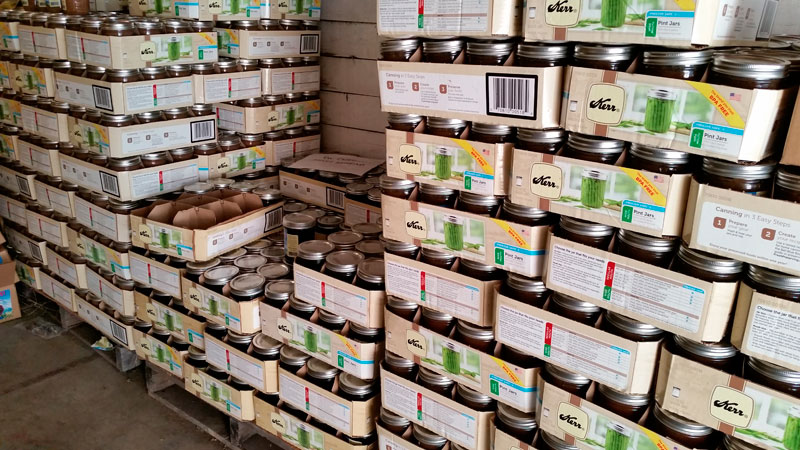
Kerr wide-mouth pint (½ litre) jars in a warehouse. Jaymethunt / pixabay.com / 2014 / CC0 1.0
Alexander Kerr’s Personal Life
Kerr was a devout Christian; for many years every case of mason jars he sold had a pamphlet in it urging people to tithe to their churches. He himself credited his financial success to tithing.
Despite his devoutness, in 1910 he divorced his first wife (name unknown at time of this writing) to marry Albertina Sechtem (July 13, 1890 – October 17, 1911) on 29th September 1910. Sechtem, who at the age of 20 was 28 years younger than Kerr, worked for him at the Kerr Glass Company at Northwest Fourth Avenue and Hoyt Street, Portland, Oregon. It caused a scandal at the time. Kerr was already 48, and the father of two children — his son Thomas was graduating from Harvard that year. [18]Hauser, Susan G. Chef’s cheesecake is a sweet tribute to Albertina Kerr’s history and namesake. The Oregonian. 4 June 2013.
Albertina and Alexander had a child, named John (born June 1911).
In October 1911, Albertina died of typhoid. He remarried a third time, to a woman named Ruth.
Kerr had two children with his first wife, one with Albertina, and an additional five children with Ruth.
When Alexander Kerr died in 1925, his eldest son Thomas took over running the company. He died in 1930. In 1930, Ruth took over running the company until her death in 1967.
….his son Thomas oversaw operations of The Kerr Glass Manufacturing Company, then located in Sand Springs, Oklahoma, until his own death five years later. Rose Kerr, Alexander’s third wife, took the reins in 1930 and her place as the first woman executive in the glass-blowing industry — if not one of the first women executives in manufacturing — in the United States.” [19]Moser, Joann. Mason Jar Nation: The Jars that Changed America. Cool Springs Press. 2016. Page 18.
Upon Ruth’s death, one of their sons, William (5 Jan 1915 to 5 Nov 2014) ran the company from 1967 until retiring in the early 1980s. [20] PASSINGS: William Kerr. Los Angeles times. 22 July 2014.
Sources
Whitten, David. Kerr Glass Manufacturing Corporation. Web page. Accessed June 2016 at https://www.glassbottlemarks.com/kerr-glass-manufacturing-corporation/
California of the South Vol. V, by John Steven McGroarty, Pages 389-393, Clarke Publ., Chicago, Los Angeles, Indianapolis. 1933.
Buying Kerr Jars
In the western United States you should be able to find them in many stores.
You can browse for Kerr Jars on Amazon. When on Amazon, be sure to compare prices to ensure you are getting the lowest price with the best shipping deal. Walmart online also carries them.
References


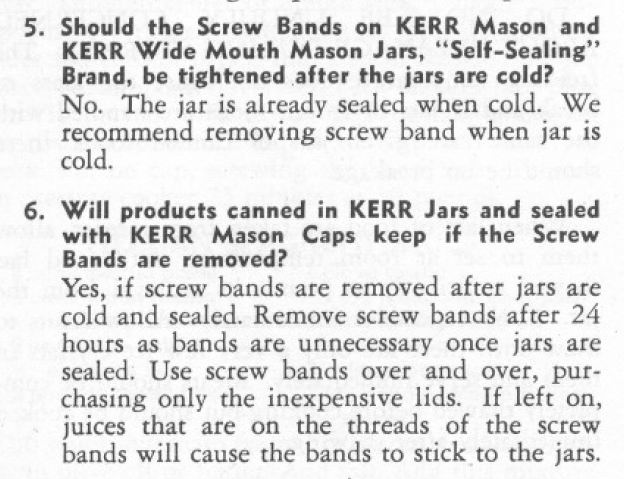
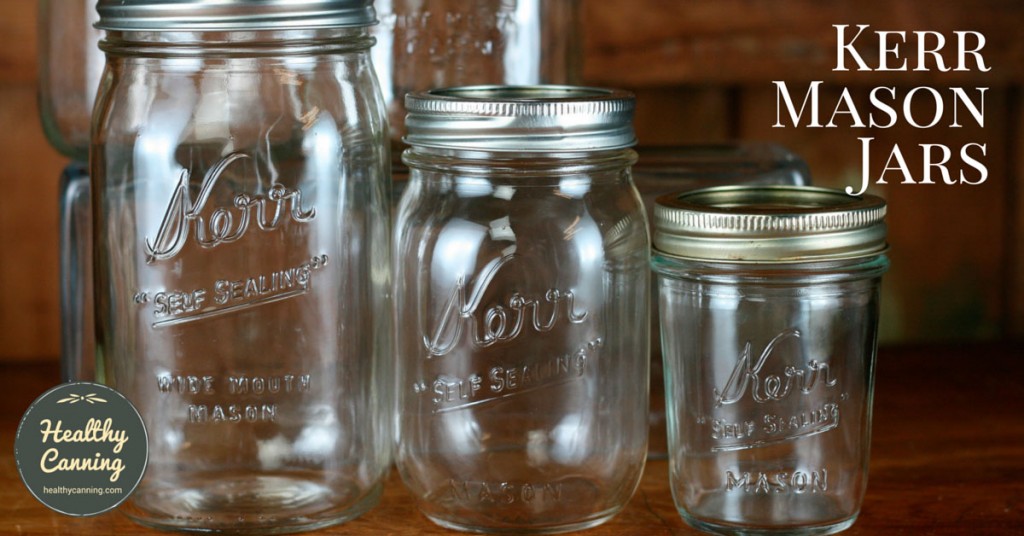
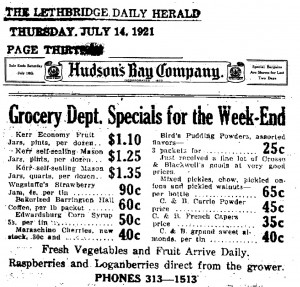
Bob Gaughen
I have had two Kerr jars fail during water bath this season. They were recently purchased here in Billings , Montana. So as you know the pickles in these jars were lost. Have you cut corners in production? This has not happened before!
Rhonda
I bought kerr jars and lids from Walmart and when I used them . Not a one of the lids sealed. I had to replace all 24 lids . I almost lost my sour kraut. I’m not happy about this product at all.
Linda
I am looking to purchase Kerr top and rings for canning. There is not any be had.. On Amazon they was $10.00 for 12 top and rings. That is uncalled for and unheard of. Might as well buy the food all ready in the can. Wish I don’t like. Can you tell me where to get tops and lids. Walmart don’t even have them.
Sandy
No one has your jars anywhere. Not at wallmart, and Amazon want’s $60.00 for a 16 0z. case. Utterly ridiculous.
Anita Delgado
I ordered Kerr lids from a website claiming to be “Kerr official”. As it is canning season I paid extra for expedited shipment. After two weeks I finally received lids from California. . . That originated from and were made in China. Is there any way to buy actual Kerr lids that are made in the USA?
DEBRA SHADE
Can I still purchase the Kerr Pickling Mix in Packages and where do you purchase them?